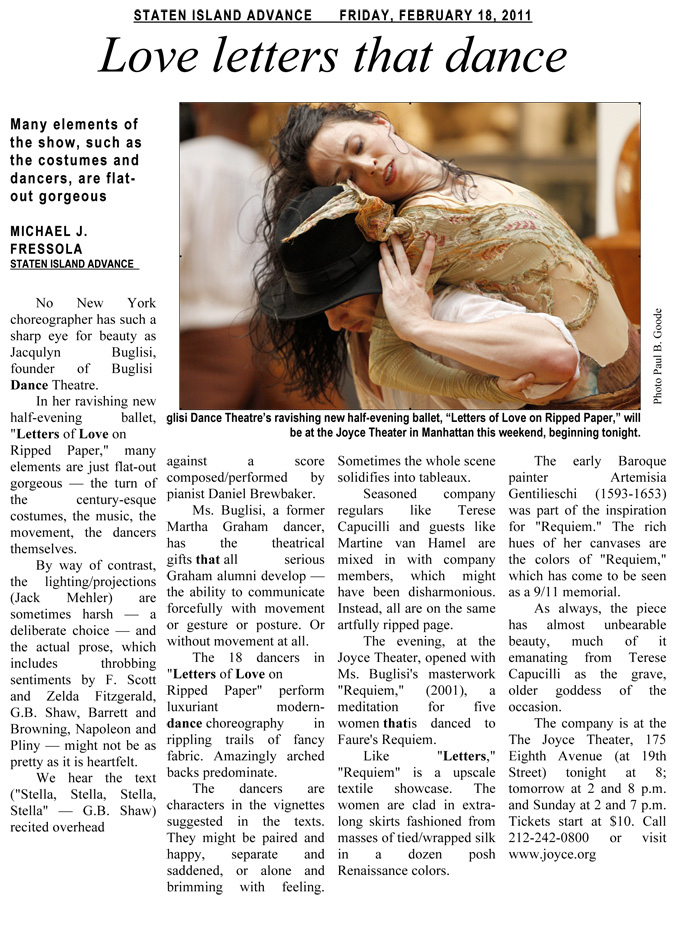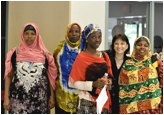For Immediate Release
Press Contact:
Audrey Ross/Publicity
212.877.3399 or audreyrosspub@aol.com
100 Dancers to present THE TABLE OF SILENCE PROJECT, a public tribute to 9/11 and prayer for peace, conceived by choreographer Jacqulyn Buglisi and Italian artist Rosella Vasta.
Tuesday September 11, 2012, 8:20 AM, ending at 8:46 AM on the Josie Robertson Plaza at Lincoln Center for the Performing Arts
Choreographer Jacqulyn Buglisi is creating a site-specific "Ceremonial Event" for 100 dancers, drawn from the New York City dance community, entitled "The Table of Silence Project," to commemorate the tenth anniversary of 9/11. Buglisi Dance Theatre is partnering on this project with Dance/NYC and The September Project. Participants are dancers from Buglisi Dance Theatre, The Juilliard School, the Martha Graham Center of Contemporary Dance, The Ailey School, National Dance Institute, Ballet Hispanico, STEPS on Broadway, and Peridance Capezio Center.
This free public event will take place Sunday September 11th at Lincoln Center's Josie Robertson Plaza. 100 dancers will gather in silent procession, forming patterns of concentric circles to create a peace labyrinth while encircling the Revson Fountain as a symbol of eternity, compassion and continuity of the life cycle. At 8:46 AM, recalling the moment when American Airlines Flight 11 crashed into the North Tower, the dancers will turn their wrists with open palms and extend their arms to the sky for one minute, evoking the simple gesture of universal peace. The dancers invite all spectators to join them in this ritual.
As described by the choreographer, "The Table of Silence Project" represents the common threads of humanity which unite all mankind into a single force with common goals and aspirations, regardless of race, culture or religion. Through this event we wish to achieve the dual purpose of celebrating and honoring peace through listening - a united moment of silence - a call for Peace in our world from NYC's community of artists." (Jacqulyn Buglisi)
Collaborators with Ms. Buglisi on "The Table of Silence Project" are Italian Artist Rossella Vasta and flautist Andrea Ceccomori. The site-specific work derives its title from Vasta's sculpture of 100 white terracotta plates representing a symbolic banquet table uniting all of humanity. This moving meditation of 100 dancers becomes the personification of the banquet table.
"The Table of Silence Project" will also be performed in other locations in the United States and Italy: October 22 at Syracuse University/NY; October 26 in Assisi, Italy as part of a series of programs organized for a multi-religious conference to be attended by Pope Benedict; and in 2012, the Center of Leadership Studies of Cardinal Stritch University/Milwaukee, and in the Porziuncola Nuova/San Francisco.
"The Table of Silence Project" at Lincoln Center will be included in The September Concert, which celebrates peace and humanity and was founded by Haruko Smith on the first anniversary of September 11. The New York-based
organization has grown to global proportions, with free concerts all around the U.S. as well as Rome, Casablanca, Tokyo, St. Petersburg, Sydney and other international sites. The mission and accomplishment of The September Concert is to bring together communities in celebration of peace and humanity. Music and dance events will take place in venues that include Lincoln Center, St. Patrick's Cathedral, Central Park, the steps of the New York Public Library, Union Square, the Winter Garden at the World Financial Center, and Rockefeller Center.
Mayor Michael Bloomberg has recently presented The September Concert with the Mayor's Proclamation for The September Concert Day. Founded under the auspices of UNESCO, with an endorsement from former President Bill Clinton, The September Concert has a current Board of Directors and Advisory Board that includes such prominent leaders and artists as Jacques d'Amboise, Faith Hope Consolo, Dr. Robert Benezra, William C. Rudin, Susan Rudin, Tom Freston, Steven Spinola, Ravi Shankar, and many others.
About Artistic Director Jacqulyn Buglisi/Buglisi Dance Theatre, Founded in 1994:
Technical excellence and unparalleled dramatic power describe the consummate artists of Buglisi Dance Theatre. The Company's extensive history of site-specific performances include such highlights as The Whitney Museum; The Rubin Museum; Dancing at the Crossroads, Times Square; the MWPAI Museum of Art; Center for British Art, Yale University; Evening Stars, Battery Park; the Special Olympics; the French Embassy's Payne Whitney Mansion; and The New York Stock Exchange/Federal Hall, commissioned by the Lower Manhattan Cultural Council and the River to River Festival. The latter inspired Alastair Macaulay to declare "Cecil B. DeMille would have been proud." (The New York Times)
A prolific choreographer, Jacqulyn Buglisi is renowned for highly visual, imagistic dances that use literature, history, and heroic archtypes as a primary source. Her repertoire of more than 70 works has been seen by audiences across America from The Joyce Theater, where BDT performs its NYC seasons, to the Kennedy Center, Jacob's Pillow Dance Festival, The Kravis Center, Dance St. Louis, the Sosnoff Theater; and abroad to Australia, the Czech Republic, Japan , Italy, and Israel. Buglisi's many commissions include the NY Flamenco Festival in Madrid, Sadler's Wells, London; The Richmond Ballet; California State Univ ersity/Long Beach; Melbourne International Festival; The Juilliard School; Ailey II; and Martha Graham Dance Co., where, as a Principal Dancer she toured worldwide and was featured on the nationally televised CBS presentation of the Kennedy Center Honors as well as in the film An Evening of Dance and Conversation with Martha Graham.
Her honors include the American Dance Guild Award, grants from the NEA, NYSCA, NYC Department of Cultural Affairs, the O'Donnell Green Music and Dance Foundation, the Harkness Foundation for Dance, the Arnhold Foundation, and Altria's Women Choreographer Initiative Award. Buglisi is Chair of the Modern Department at The Ailey School, and serves on the Board of Trustees of Dance/USA as Chair of Artistic Directors Council. www.buglisidance.org
Rossella Vasta, renowned Umbrian painter, is the first prize winner of the 2003 Biennial of Florence. Since exhibiting her first solo show in Spoleto in 1981, she has exhibited in galleries around the world from Poland and Japan to the United States at University of Bozeman, Montana; the Chautauqua Institute; American University in D.C., and the Cardinal Stritch University in Milwaukee. She is the founder/director of the Pieve International School in Corciano, Perugia, Italy. Ms. Vasta is committed to charitable works through her Arts Sustainability Projects, helping to realize a school and farm in the Ivory Coast, among other projects, and to support a healthcare center in Citta della Pieve.
Sponsorship for 100 terracotta plates is generously provided by Bizzirri Ceramic Factory (www.bizzirri.it) and for the 100 mantels for the dancers by Alessandro Gherardi, Città di Castello - Perugia, Italy.
A ‘Requiem’ Unwraps Stillness Swathed in Silk
By GIA KOURLAS Published: February 16, 2011 Excerpts…
The dances of Jacqulyn Buglisi could be likened to a powdery musk…In the two works Buglisi Dance Theater presented Tuesday night at the Joyce Theater — “Requiem” from 2001 and “Letters of Love on Ripped Paper,” a premiere for 18 dancers — she demonstrates her usual sensual depiction of female characters. A former member of the Martha Graham Dance Company, she punctuates sharp movement — a contraction drives the back to twist in angst — with a dreamy, floating quality. Arms rise and frame the face to show longing, headiness, joy or despair.
In “Requiem,” set to Fauré’s music, the curtain opens on a stage featuring five rectangular shapes covered with fabric. Suddenly, those blocks come to life as women rise, arching their bare backs under Clifton Taylor’s dusty lighting…
“Ripped Paper,” inspired by love letters throughout history that are recited by live readers, including the Graham veteran Christine Dakin, a company member, or heard on recordings. It begins with Victor Hugo’s words to Adèle Foucher: “Your soul is made to love with the purity and passion of angels.”
…In many ways “Ripped Paper,” which features music by Daniel Brewbaker and an assortment of wide-brimmed hats, is another painterly dance… There are some stars in the cast: Martine van Hamel, of American Ballet Theater, saucily acts out a letter, read by a gravel-voiced Ms. Dakin, from a wife to her husband during the Civil War. Terese Capucilli, Virginie Mécène and Rika Okamoto — all former Graham dancers — drift through the piece, with Ms. Okamoto… showing the most guileless abandon.
As the dance progresses from one letter to the next, Ms. Buglisi employs something akin to the Ken Burns style — projected text flashes by on a backdrop. Four men periodically escape their partners to leap into the air in vigorous, unison jumps; the women counterbalance such virility by gliding aimlessly, as if lost in thought.
…“Do you hate me? I love you, I want you, it’s burning hell without you.” This is love, Harlequin style.

NYC dance troupe
interprets refugees'
love letters
By CASSAUNDRA BABER
Observer-Dispatch
UTICA —


“I love my country all single day, I remember all my friends, my neighborhood, my work,” a dancer read from the love letter Santiago wrote as an assignment for her English as a second language class at the Mohawk Valley Resource Center for Refugees. “Once I go to bed and put my head on the pillow, my first thought is about you, my country …”, the Cuban refugee wrote.
Two upper level ESL classes at the center submitted letters as inspiration for the dancers, who are completing a three-week residency at Munson-Williams-Proctor Arts Institute’s School of Dance, thanks to a New York State Council on the Arts grant. The troupe is using their stay at the refugee center to create new work and garner new audiences — including the refugees, students from area schools and dancers.
Forty-year-old Santiago’s English might be broken; she might still confuse her verbs and forget pronunciations, but each word and all its passion became clear while she and about 40 of her peers watched the dancers interpret 15 refugees’ love letters.
“I think sometimes when you’re teaching writing, it feels like you’re doing something extra – like the students don’t feel like it’s worthwhile,” said ESL instructor Sharon Vogelaar. “But to have their feelings on paper and see their words through this universal language means a lot.”
For Iraqi refugee, Aaeda Ismael, 53, the interpretation became especially meaningful when the dancers’ movements showed similarities to the dances performed in her native land. “The dance reminded me of my home, my people, happier times,” she said after showing the dancers and refugees a form of a native dance that included her arms circling above her head and snaking the through her body to her feet. The dancers swiftly formed a half-circle around Ismael, mimicking the movements. “Dance to me is peace and happiness, and I don’t want this traditional dance to be dead.”
During what Artistic Director Jacqulyn Buglisi called a rehearsal at the MWPAI Dance Studio, she asked refugees to read from their letters in their native tongues while dancers moved to the rhythm of their words.
“Ewe wangu wa moyoni. Sulu hizi umekuwa sina hali kwa mawazo,” read Fartun Ali, 22, in Somali. (Translated in English, the letter to Ali’s husband, who she had to leave behind in Dallas, reads: “Dear sweetheart. These days the time I have only have thoughts of you.”)
Only a few understood the words as spoken, but everyone seemed to understand the emotion created when a male and female dancer embraced, intertwined and twisted around each other.
“We as artists want to bridge the boundary through the universal language of dance,” Buglisi said. “The love letters are very metaphoric.” Metaphoric, because love, like dance, is universal, she said. That idea became especially apparent in the subjects of the refugees’ letters, which were addressed to freedom, their native countries, loved ones and even music.
“They’re torn between the love of their country, love of family, love of their legacy, and they come here to our country where they have the freedom that they’ve dreamed of,” Buglisi said. “Isn’t that what America’s all about?” Ultimately, Buglisi said, spreading that message through dance moves it forward and gives it greater impact. “Maybe we’re a small institution, but in a way it’s a bigger message,” Buglisi said. “The more we work with the community, the more impact we have on each other.”
That impact will last long after the troupe leaves, said Nancy Long, who heads Munson-Williams’ dance program. “Everywhere they go they are enriching our community,” Long said of the dancers. “They’re spending their dollars here; they’re enjoying fine-dining throughout Utica. It’s a complete win-win situation; and another situation where arts and economics make sense, and that what we’re doing brings attention and focus and dollars to our community and to Munson-Williams, which makes me most proud.”
